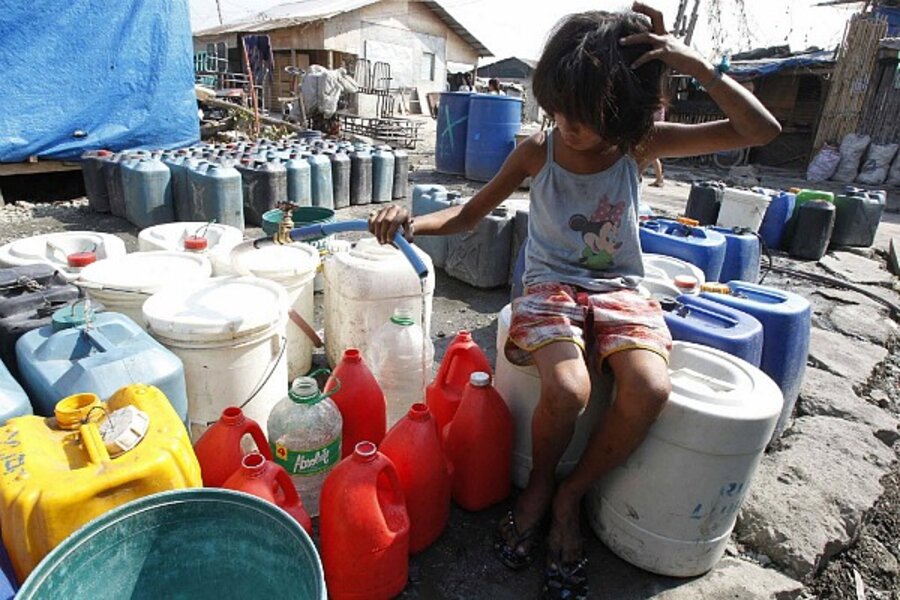Answering the world's growing water problem
Loading...
| Washington
The portion of the global population living in conditions of at least moderate stress involving water – everything from conflict over access to failing traditional sources and lack of access to clean water – will rise to two-thirds by 2025.
In other words, two of every three people on the planet will have some form of a water problem, experts say.
Yet as grave as that scenario sounds, specialists gathered at an international water summit in Washington Friday emphasized that even a world of reduced development-assistance budgets has the tools to vastly improve – if not solve – the coming global water challenge.
IN PICTURES: World Water Day 2011
Among the keys to addressing the water challenge will be sustainability, conservation, technological innovation, and local solutions.
Out: giant hydro dams and other one-stop – and prohibitively expensive – solutions to a developing nation’s challenge.
In: rooftop rainwater collection and other micro-solutions that involve families, communities, and the small-scale private sector.
“The problem is not so much scarcity, but management,” said Maria Otero, the US under secretary for democracy and international affairs, speaking at the summit. “Even in the driest regions of the world,” she added, “we can achieve water security with the right water management.”
The summit was sponsored by two historic Rotary Clubs: Washington’s, which is about to celebrate its centennial; and the Rotary Club Paris Academies, which has been meeting for over a half-century on Paris’s Left Bank.
The summit included the participation of ambassadors from more than 20 developing countries, as well as representatives of NGOs deeply involved in the world’s global water challenge.
For all those who feel they’ve heard about an impending water crisis for decades, experts say they’re right.
“The water issue has waxed and waned” over the last three decades, says Steve Hollingworth, executive vice-president for global operations at CARE. The driver of those ups and downs was most often developed-world governments running hot and cold on the issue, experts say.
Water was included in a variety of ways in the United Nations’ Millennium Development Goals for 2015 set in 2000. But in the meantime, tight national budgets have hit wealthy donor countries and their assistance budgets.
But other experts say new reasons have surfaced to put water back at the top of the global development agenda.
“The environmental movement is one reason for the upswing in interest in water, but a second reason is global warming,” says Arthur Keys, president and CEO of International Relief and Development (IRD), based in Arlington, Va. “That’s caused people to realize that some of our water resources we’ve depended on aren’t going to be here.”
He cites an example from the State Department’s Under Secretary Otero, who recalls how in her native Bolivia, one region depended for centuries on the water from one glacier. “Now that glacier is gone,” he says.
The era of big-ticket infrastructure projects to meet water needs is largely of the past, Mr. Keys says, because rich countries no longer have the budgets to bankroll such projects – and also because such projects too often require expensive maintenance.
“Sustainability is the new key to the water challenge,’ he says.
Reforming wasteful water uses will be one answer to the challenge. Otero notes that Pakistan uses over 90 percent of its water resources for irrigation – “they flood irrigate,” she says – but that about two-thirds of the water pumped into irrigation systems is lost to ground seepage.
IRD’s Keys highlights his organization’s roof water collection project in Zimbabwe. The project has flourished, he says, in large part because the materials for the systems – the gutters and pipes and collection tanks – were integrated from the outset by having local small entrepreneurs develop and supply the parts.
Now the program is being replicated in neighboring Mozambique.
“One of the reasons that program has succeeded is that it presents a viable business model at the local level,” Keys says.
Another attractive aspect of rooftop water collection is the impact it has on women – the half of the population that experts say will be key in addressing the developing world’s water challenge.
In Zimbabwe, as in many other places, poor women have often had to spend large parts of the day simply going to draw water at some distant spot to bring back to their homes. But with water collected in a tank right outside the house, that can change.
“Such distribution system freed up women for other activities with children and education,” Keys says.
Two development challenges addressed – with one water tank.





